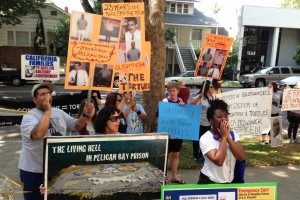One of the largest inmate hunger strikes in state history has entered its fourth week, but the mass protest hasn’t seemed to attract the attention of California’s leaders.

Gov. Jerry Brown has yet to publicly weigh in on the strike – his office has referred all questions about it to the Department of Corrections and Rehabilitation. And when KQED contacted Assembly Speaker John Perez and Senate President Pro Tem Darrell Steinberg about the protest last week, both leaders’ offices declined to comment.
The lack of response has the families of striking prisoners frustrated. “We need more people out here, we need more news coverage out here,” Silvia Rogokos told a group of protesters at the state Capitol Tuesday morning. “Because nobody cares about inmates.”
The primary focus of the strike is to pressure the state to end, or at least limit, the practice of isolating prisoners in long-term segregated housing. Rogokos said her brother, Frank Reyna, has spent more than two decades in Pelican Bay’s Security Housing Unit, or SHU. She worries the prolonged isolation has permanently damaged Reyna, who was convicted of second-degree murder. “They’re kept in these cells for 22 hours. They go out and exercise in what looks like a dog pen. There’s no rehabilitation for them, (so) how can he better himself? “
Corrections officials insist the segregated housing is needed to control gang leaders and dangerous criminals. CDCR spokesman Jeffrey Callison said, “The reality is that inmates in the security housing unit determine themselves how long they’re there for. They can get out of the housing units through renouncing their connection to a gang, through behavior improvements and through debriefing.”